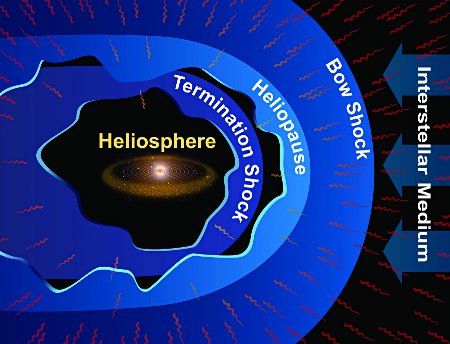Riding the solar wind with some kind of magnetic sail is one path into the outer Solar System, but before we can develop an operational technology around the idea, we have to learn much more about how the solar wind works. This stream of charged particles flows outward from the Sun at great speed — up to well over 400 kilometers per second — creating the ‘bubble’ in the interstellar medium known as the heliosphere, within which our Solar System exists. Understanding how that wind interacts with the true interstellar space that lies beyond will give us a better idea of its properties and those of the boundary region at system’s edge.

Image: The Solar System in context, placed within the heliosphere created by the solar wind. Credit: Southwest Research Institute.
IBEX (Interstellar Boundary Explorer) is a space mission that may tell us more as it examines the edge of the heliosphere. Tuned up after two months of commissioning, the spacecraft is now gathering data, mapping the interactions between the solar wind and the interstellar medium by measuring energetic neutral atoms from the Solar System’s edge. Thus we complement and extend the early heliosphere data provided by the Voyagers and investigate how charged solar wind particles behave in this critical area, through which any mission into the interstellar void will have to pass. The data thus far are useful, but only a beginning:
“We are seeing fabulous initial results from IBEX, but just as artisans use looms to build up colorful textiles by weaving one thread at a time, the IBEX sensors also need time — six months — to build up a complete map of the sky,” says Dr. David McComas, IBEX principal investigator and senior executive director of the Space Science and Engineering Division at Southwest Research Institute. “So far, the intricate pattern of this fascinating interaction is only just beginning to disclose itself to us.”
This is useful information not only in terms of understanding how our local neighborhood interacts with the galaxy around it, but also in analyzing how this distant region helps to shield the Earth from a great deal of cosmic ray radiation. Also useful would be an accurate picture of the shape of the heliosphere, and how it may be affected by magnetic fields in the interstellar medium. Given the target of its study, it’s interesting to reflect that IBEX is relatively close — in Earth orbit — although a very high one reaching five-sixths of the way to the Moon. Much of that orbit is outside Earth’s magnetosphere, critical for accurate observations.


Added to the Astronomy Link List
Hi Paul;
A magsail would be a wonderful technology that would permit velocities essentially as great as the solar wind velociities.
With all of the charged matter or plasma comming off the Sun and traveling to the outer boundaries of the planetary solar system, one wonders whether or not some sort of electrodynamic-hydrodynamic-plasma drive system could be developed that utilizes some of the plasma as a back-thrust based reaction mass.
Such hydrodynamic drives might include the usual mantra of magneto-plasma-hydrodynamic drives, electro-plasma- hydrodynamic drives, and electromagneto-plasma-hydrodynamic drives.
Electrodynamic-hydrodynamic-plasma drive systems have a maximum theoretical velocity approaching C or atleast C – e where e can be made very small in comparison to C. If the energy to power the electrodynamic-hydrodynamic-plasma drive system could be derived from matter antimatter interactions, or perhaps better yet, from zero point field energy extraction methods, we might oneday see ships exiting our solar system at essentially C.
But first things first, we definately need an accurate mapping of the solar wind, solar magnetosphere, and the heliopause. I suspect that a magsail could be developed in a couple of decades whereas the more extreme examples of electrical propulsion concepts I listed above will probably take quit some extra doing.
I’m sorry to say that IBEX has the worst website of any space mission I’ve ever seen.
Doug M.